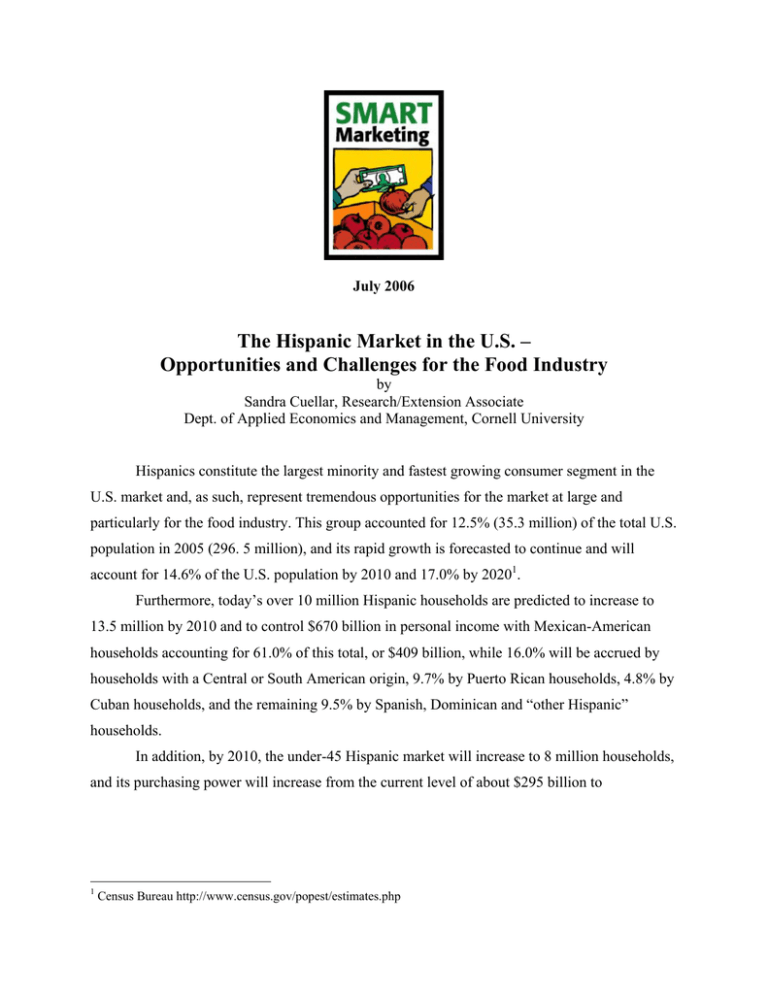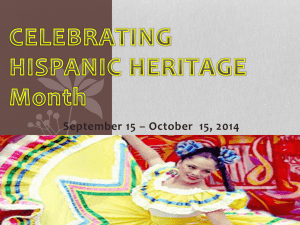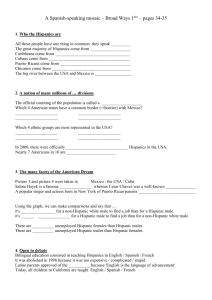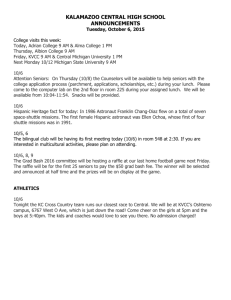The Hispanic Market in the U.S. –
advertisement

July 2006 The Hispanic Market in the U.S. – Opportunities and Challenges for the Food Industry by Sandra Cuellar, Research/Extension Associate Dept. of Applied Economics and Management, Cornell University Hispanics constitute the largest minority and fastest growing consumer segment in the U.S. market and, as such, represent tremendous opportunities for the market at large and particularly for the food industry. This group accounted for 12.5% (35.3 million) of the total U.S. population in 2005 (296. 5 million), and its rapid growth is forecasted to continue and will account for 14.6% of the U.S. population by 2010 and 17.0% by 20201. Furthermore, today’s over 10 million Hispanic households are predicted to increase to 13.5 million by 2010 and to control $670 billion in personal income with Mexican-American households accounting for 61.0% of this total, or $409 billion, while 16.0% will be accrued by households with a Central or South American origin, 9.7% by Puerto Rican households, 4.8% by Cuban households, and the remaining 9.5% by Spanish, Dominican and “other Hispanic” households. In addition, by 2010, the under-45 Hispanic market will increase to 8 million households, and its purchasing power will increase from the current level of about $295 billion to 1 Census Bureau http://www.census.gov/popest/estimates.php approximately $397 billion. This means that about $3 out of every $5 earned by Hispanic households will be in the hands of this younger-than average segment2. Opportunities that the Hispanic market represents for the food industry in the U.S. are related not only to its dynamic growth and increasing purchasing power but, very importantly, to the spending patterns, shopping habits and food preferences associated with Hispanic culture heritage and traditions. However, along with these opportunities, food marketers face significant challenges mostly related to the diversity of countries of origin and the different levels of acculturation of Hispanic consumers in the U.S3. Relevant Hispanic Cultural Heritage4,5,6 • Communicating in Spanish, a strong sense of family and pride in their food traditions constitute common denominators of Hispanics. • Family relations are reinforced through frequent celebrations and social gatherings, including birthdays, baptisms, weddings, graduations and holidays. • Good food is at the center of most celebrations. • Cooking traditional meals is regarded as important to the family. • Love among family members is often expressed through the act of cooking and, particularly, through the preparation of meals from scratch, with spices and fresh ingredients. • All these traditions are passed on from one generation to the next. Opportunities Related to Hispanics’ Spending Patterns7 • Hispanics don’t eat out very often. • They cook dinner at home 5.6 times a week. • They spend more on food than non-Hispanics at almost $130 per week versus $91 per week. • On average, they spend 47% more per year on produce as compared to non-Hispanics. 2 U.S. Hispanic Population to Reach 13.5 million households by 2010. PMA Freshline. Vol. 36, No. 46. November 17, 2004 3 Salsa Outselling Ketchup? Marketing to Hispanics is Hot. Knowledge at Wharton. http://knowledge.wharton.upenn.edu., November 2004. 4 Ibidem (Knowledge at Wharton, 2004) 5 U.S. Hispanics: Insights into Grocery Shopping, Preferences and Attitudes, 2002. Food Marketing Institute, Washington D.C., several pages 6 Eye on Food – Hispanics Bring Together Family and Food. FMI Supermarket Research, Vol. 4 Nr. 3, June 2002. 7 Hispanics and Fresh Produce. Produce Marketing Association (PMA) – Industry Facts Sheet, 2004. p.5 2 • They spend $228 on fruits and vegetables each, versus the national average of $157 and $152, respectively Opportunities Related to Hispanics’ Shopping Habits8 • Hispanics shop for groceries more often, at an average of 26 grocery trips per month, three times the frequency of the general U.S. population9. • Supermarkets are the most common type of store for purchasing groceries among Hispanics, but they also spend over 30% of their total food dollars at non-supermarket stores, compared to 18% for all U.S. shoppers. • Typical non-supermarket stores frequented by Hispanics include butcher shops, bakeries, bodegas, convenience stores, drug stores, specialty shops and warehouse store. • Hispanics shop mostly on Sundays after church, spend more time shopping and also shop more as a family. Opportunities Related to Hispanics’ Food Preferences: • Foods prepared from scratch and fresh ingredients are believed to be more nutritious than packaged foods. • Hispanics buy more fresh food than processed foods. • They prefer bulk over packaged products. • Fragrance in very important, with 60% smelling a product before buying it. Challenges Related to Country of Origin According to the latest U.S. Census of Population (2000), people of Mexican heritage make up 67% of the U.S. Hispanic population, followed by Central and South Americans at 14.3%, Puerto Ricans at 8.6% and Cubans at 3.7%10. Important holidays and the dates in which they are celebrated as well as favorite foods can vary significantly from one country to another, as illustrated in Tables 1 & 2. Such diversity obviously has a significant impact on the choice of products as well as on the best marketing and promotional strategies any marketer such employ. 8 Ibidem (PMA, 2004) FMI Update: Ethnic Foods Offer “Much Bigger” Opportunity for Retailers, Experts Say 10 Salsa Outselling Ketchup? Marketing to Hispanics is Hot. Knowledge at Wharton. http://knowledge.wharton.upenn.edu., November 2004. 9 3 Table 1. Key Holidays by Country of Origin January February March 6 - Three Kings Day (Mexico, Puerto Rico, Colombia) 27 – Independence Day (Dominican Republic) Early March Carnival (Miami, Brazil, New Orleans) April May June 5 – Cinco de Mayo (Mexico) 25 – Revolution Day (Argentina) 9 – Puerto Rican Day Parade (New York) World Cup August September July 20 – Independence Day (Colombia) 28 – Independence Day (Peru) 31 – Feast of St. Ignatius Loyola (Spain) World Cup October 7 – Independence Day (Brazil) 16 – Independence Day (Mexico) 18 – Independence Day (Chile) November December 1 – All Saints Day (Catholic) 7 – Independence Day (Ecuador) 12 – Our Lady of Guadalupe (Mexico) 16-24 Navidades (Puerto Rico, Colombia), Posadas (Mexico) Source: Hispanics and Fresh Produce. Produce Marketing Association – Industry Facts Sheet, 2004 p. 6 Table 2. Favorite Produce by Hispanic Group All Hispanics Cilantro Puerto Rican & Caribbean Pepino melon Mexican Tomatillo Avocado Malanga Chiles (many varieties) Plantain Sapote Yam Yucca root Chile, caribe yellow Corn husk Mango Boniato Beans Bananas Fava beans (fresh) Jicama Squash Baby bananas Cactus pear Coconut Black beans Cactus leaves Papaya Red beans Beans Tamarindo pods Corn Source: Hispanics and Fresh Produce. Produce Marketing Association – Industry Facts Sheet, 2004 p. 3 4 Challenges Related to Level of Acculturation Acculturation, defined as the adaptation to the new cultural patterns of a dominant culture, plays a significant role in shaping the behavior of Hispanic consumers in the U.S.11, who, in general, want to acculturate but not to assimilate. Acculturation can occur at different rates and, in fact, when Hispanics develop their own communities, they feel less need to interact with mainstream America and to acculturate12. Research has shown that food preferences and shopping habits of Hispanics will vary widely, depending on their level of acculturation13. In general, newly arrived Hispanics tend to shop in small, urban stores, while those whose families have been in the country longer are more likely to buy at retail chains and to shop at different supermarkets14. Segmentation Approaches to the Hispanic Market in the U.S. Although there are many factors that reflect the level of acculturation, language preference is a primary indicator that consistently reveals salient differences among Hispanic consumers15. On the basis of language preference, the Hispanic market can be classified into three segments: a first generation of Spanish-dominant families; a second generation of bilinguals and a third generation that is English-dominant and upwardly mobile16. Another approach to segmenting the Hispanic market has been proposed on the basis of a study co-sponsored by ADVO, FMI and New American Dimensions which takes into account the demographic, attitudinal and shopping behavior characteristics of Hispanics in the U.S.17. According to this study’s results. Hispanics can be classified into four segments: loyalists, budgeters, impulsives and inquirers, as follows. 11 U.S. Hispanics: Insights into Grocery Shopping, Preferences and Attitudes, 2002. Food Marketing Institute, Washington D.C., p. 6 12 Salsa Outselling Ketchup? Marketing to Hispanics is Hot. Knowledge at Wharton. http://knowledge.wharton.upenn.edu., November 2004. 13 U.S. Hispanics: Insights into Grocery Shopping, Preferences and Attitudes, 2002. Food Marketing Institute, Washington D.C., p.6 14 Morse David and Bishop Bill, Seeing Opportunity in Hispanic Shopper Behavior. Retailwire http://www.reatilwire.com 15 U.S. Hispanics: Insights into Grocery Shopping, Preferences and Attitudes, 2002. Food Marketing Institute, Washington D.C., p. 6 16 It’s time to think Latino. Connie Gore. GlobeStRetail. http://www.globest.com. June 27, 2005 17 A study conducted with 1,650 Hispanic consumers in the top 10 markets across the U.S in: Morse David and Bishop Bill, Seeing Opportunity in Hispanic Shopper Behavior. Retailwire http://www.reatilwire.com 5 • Loyalists (20% of the shoppers): those most brand loyal, typically less acculturated shoppers who are looking for familiar brands and are much less willing to try new ones, even when they are on sale. • Budgeters (25% of the shoppers): also less acculturated. They typically operate under strict budgets and are very responsive to specials. • Impulsives (30% of the shoppers): the largest segment, they typically have been in the U.S. longer but still have a strong Hispanic identity. They enjoy food shopping and use food to pass along their Hispanic heritage to their children. • Inquirers (25% of the shoppers): the most acculturated on many different measures. They take a “more educated” approach to shopping. They look carefully at the ads and deals, and are less concerned about traditional Hispanic products. They are also the most likely to shop across different channels. Yet another approach is suggested by the Wharton School of Business - University of Pennsylvania, that proposes to think of this market as one composed of younger than average families that tend to live in multigenerational households, that are most likely to make decisions as a group and tend to be brand loyal18. "Smart Marketing" is a monthly marketing newsletter for extension publication in local newsletters and for placement in local media. It reviews the elements critical to successful marketing in the food and agricultural industry. Articles are written by faculty members in the Department of Applied Economics and Management at Cornell University. "Share the gift of communication." Please cite or acknowledge when using this material. 18 Salsa Outselling Ketchup? Marketing to Hispanics is Hot. Knowledge at Wharton. http://knowledge.wharton.upenn.edu. November 2004. 6






